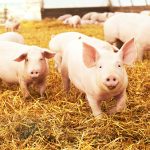Dairy cows in Nigeria can be affected by a variety of diseases that can reduce milk production, cause health problems, and even lead to death. Here are some of the common diseases that affect dairy cows in Nigeria:
1. Mastitis: This is an inflammation of the udder tissue, usually caused by bacterial infection. It can cause swelling, redness, and pain in the udder and can lead to reduced milk production or even loss of the cow’s udder. Mastitis can be prevented through good hygiene practices and proper milking techniques.
2. Foot and Mouth Disease (FMD): FMD is a highly contagious viral disease that affects cloven-hoofed animals, including dairy cows. It can cause fever, blisters, and lameness, and can lead to a decrease in milk production. FMD can be prevented through vaccination and good biosecurity measures.
3. Bovine Respiratory Disease (BRD): BRD is a common respiratory disease in dairy cows, caused by bacterial or viral infections. It can cause coughing, fever, and difficulty breathing, and can lead to decreased milk production. BRD can be prevented through good hygiene practices and proper ventilation in the cow’s housing.
4. Trypanosomiasis: This is a parasitic disease caused by tsetse fly bites, which can lead to anemia, weight loss, and decreased milk production in dairy cows. Trypanosomiasis can be prevented through goodvector control measures, such as using insecticides and traps, and avoiding grazing in areas with high tsetse fly populations.
5. Brucellosis: Brucellosis is a bacterial infection that can cause reproductive problems, such as abortion, stillbirth, and decreased milk production, in dairy cows. It can be transmitted to humans through the consumption of contaminated milk or meat. Brucellosis can be prevented through vaccination and good hygiene practices.
6. Tick-borne diseases: Tick-borne diseases, such as anaplasmosis and babesiosis, can cause fever, anemia, and decreased milk production in dairy cows. These diseases can be prevented through good tick control measures, such as using acaricides and avoiding grazing in areas with high tick populations.
7. Parasitic infections: Parasitic infections, such as gastrointestinal nematodes and liver flukes, can cause weight loss, diarrhea, and decreased milk production in dairy cows. These infections can be prevented through good pasture management practices, such as rotational grazing and deworming.
8. Ketosis: Ketosis is a metabolic disorder that can occur in dairy cows during periods of high milk production, causing weight loss, decreased milk production, and other health problems. It can be prevented through proper nutrition and management practices, such as feeding a balanced diet and avoiding sudden changes in diet.
9. Milk Fever: Milk fever is a metabolic disorder that can occur in dairy cows after calving, causing weakness,reduced milk production, and other health problems. It can be prevented through proper nutrition and management practices, such as ensuring adequate calcium intake and avoiding overfeeding during late pregnancy.
10. Leptospirosis: Leptospirosis is a bacterial infection that can cause fever, anemia, and reproductive problems in dairy cows. It can be transmitted to humans through the consumption of contaminated milk or meat. Leptospirosis can be prevented through vaccination and good hygiene practices.
In summary, dairy cows in Nigeria can be affected by a variety of diseases that can cause significant health problems and reduce milk production. Preventing these diseases requires good management practices, including proper nutrition, housing, sanitation, and hygiene, as well as regular veterinary care and monitoring of the health status of the cows. Veterinarians and experienced dairy farmers can provide guidance on disease prevention and treatment in dairy cows.




















